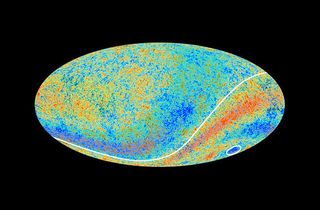Planck's Mystery Cosmic 'Cold Spot' May Be an Error

The European Planck space telescope detects very faint primordial radiation that was generated after the Big Bang — when the universe was only 380,000 years old. By creating a cosmic map of the slight variations in this cosmic microwave background (CMB) radiation — variations known as "anisotropies" — cosmologists have been able to gain some clue as to the structure of the Universe nearly 14 billion years ago.
However, several anomalies in the CMB map have confused the scientific community; some mysterious features mapped by Planck don't agree with established theory as to how the Cosmos works. Is there some exotic new cosmology at play? Or are these features simply observational error?
NEWS: Universe Older Than Thought, New Map Reveals

One of the more exotic explanations for the cold spot is that it could be observational evidence for the "multiverse"— a hypothesis with roots in superstring theory where our universe exists in an ocean of other universes — and the cold spot is caused by a neighboring universe pushing up against ours. Unfortunately, the feature might not even be real.
"Using new techniques to separate the foreground light from the background, and taking into account effects like the motion of our Galaxy, we found that most of the claimed anomalies we studied, like the cold spot, stop being problematic," said lead researcher Anaïs Rassat, of the Ecole Polytechnique Fédérale de Lausanne, Switzerland.
Get the Space.com Newsletter
Breaking space news, the latest updates on rocket launches, skywatching events and more!
ANALYSIS: Will Science Burst the Multiverse's Bubble?
Rassat’s team’s work has been published today (Aug. 4) in the Journal of Cosmology and Astroparticle Physics.
When mapping such faint radiation that has been traveling through space-time for billions of years, it is difficult to separate the primordial signal from other microwave sources. Our galaxy, for example, swamps the universal vista with microwaves and, as we live inside the galactic disk, our microwave view is dominated by Milky Way emissions. It's a thick cosmic fog that needs to be subtracted.
Through complex algorithms and foreground emission subtraction techniques, these extraneous microwave sources can be effectively removed. But Rassat's team gave the data another pass, correcting for the motion of our galaxy and other impacts such as gravitational interference and distortions in the radiation itself.
Although this study appears to have corrected for previously overlooked effects in Planck observations, some anomalies remain in the data, leaving room for some of the more exotic hypotheses about the origin and nature of our universe. But as for Planck's "cold spot," that mystery might be down to observational error and not something real.
This article was provided by Discovery News.
Join our Space Forums to keep talking space on the latest missions, night sky and more! And if you have a news tip, correction or comment, let us know at: community@space.com.
Ian O'Neill is a media relations specialist at NASA's Jet Propulsion Laboratory (JPL) in Southern California. Prior to joining JPL, he served as editor for the Astronomical Society of the Pacific‘s Mercury magazine and Mercury Online and contributed articles to a number of other publications, including Space.com, Space.com, Live Science, HISTORY.com, Scientific American. Ian holds a Ph.D in solar physics and a master's degree in planetary and space physics.
